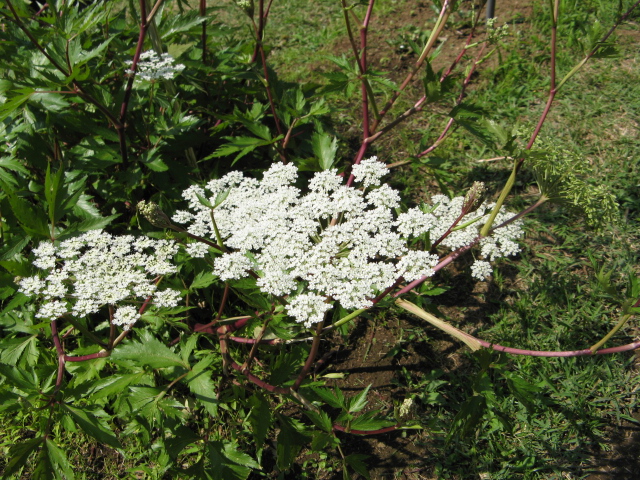Benutzer-Werkzeuge
Angelica acutiloba (Siebold & Zucc.) Kit. - syn.Ligusticum acutilobum Siebold & Zuccarini - Apiaceae
トウキ 当帰 tōki (jap.), Japanese angelica, Japanische Engelwurz
Perennial herb, 30–100cm high, native to Japan and Korea, cultivated there; root yellow-brown, strongly aromatic.
„The roots are used in Jilin as a regional substitute for the traditional Chinese medicine dang gui (see Angelica sinensis).“ http://www.efloras.org/florataxon.aspx?flora_id=2&taxon_id=200015350
„The Traditional Chinese medicine uses the root of a different species A. sinensis, Chinese: 当归; pinyin: dāngguī. The Latin pharmacological name for the crude drug, Radix Angelica sinensis, refers to the dried roots of A. sinensis. In China, as a substitute species, A. acutiloba, is known as Chinese: 东当归; pinyin: dōngdāngguī. Literally “东” means “eastern” or “东洋”, which is equivalent to the meaning of Japan. So the medicine is also called as Japanese Angelica root. The Japanese name, tōki (トウキ, 当帰?), has a literally meaning like “recovering good health”.“ http://en.wikipedia.org/wiki/Angelica_acutiloba
„Anti-nociceptive constituents of the Chinese crude drug Toki (the roots of Angelica acutiloba var. acutiloba Kitagawa) were investigated by means of chemical fractionation and bioassay. Seven active compounds that inhibit AcOH-induced writhing in mice have been isolated from Toki for the first time and identified as falcarinol, falcarindiol, falcarinolone (polyacetylenes), choline, scopoletin, umbelliferone and vanillic acid. Among these, the three polyacetylenes were found to be most active in the writhing test.“
[Anti-nociceptive substances from the roots of Angelica acutiloba. Tanaka, S., Ikeshiro, Y., Tabata, M., Konoshima, M., Arzneimittel-Forschung, Vol.27(11), 1976, 2039-2045]
„Dried roots of Angelica acutiloba (Yamato-toki in Japanese) are one of the popular varieties of Traditional Chinese Medicine (TCM) that have been used for its pharmacological benefits in treating female gynecological illnesses, such as menstrual disorders, urgent premature birth, and menopause. For these reasons, Yamato-toki roots arewidely commercialized in Japan. However, as Yamato-toki roots are traditional medicines sold primarily by professional herbalists, commercial values of them are determined by their subjective observations of smell, taste and appearances.“
[Metabolic profiling of Angelica acutiloba roots utilizing gas chromatography–time-of-flight–mass spectrometry for quality assessment based on cultivation area and cultivar via multivariate pattern recognition. Tianniam, S., Tarachiwin, L., Bamba, T., Kobayashi, A., Fukusaki, E., Journal of bioscience and bioengineering, 105(6), 2008, 655-659]
„Insecticidal activity of Angelica acutiloba extract and its constituents was investigated and compared with that of rotenone. Bioassay-guided isolation of the chloroform extract of A. acutiloba against larvae of Drosophila melanogaster afforded two phthalides, (Z)-butylidenephthalide (1) and (Z)-ligustilide (2), and two furanocoumarins, xanthotoxin (3) and isopimpinellin (4)… To determine the insecticide mode of action for acute adulticidal activity, acetylcholinesterase (AChE) inhibitory activity was also investigated in vitro, and the result indicated that the acute adulticidal activity of compounds 3 and 4 was due to the inhibition of AChE.“
[Insecticidal effect of phthalides and furanocoumarins from Angelica acutiloba against Drosophila melanogaster. Miyazawa, M., Tsukamoto, T., Anzai, J., Ishikawa, Y., Journal of agricultural and food chemistry, 52(14), 2004, 4401]

Angelica acutiloba, Author: Pieria, PD (CC0)
https://commons.wikimedia.org/wiki/File:Angelica_acutiloba-01.jpg
